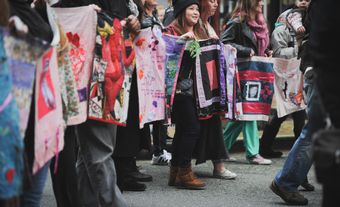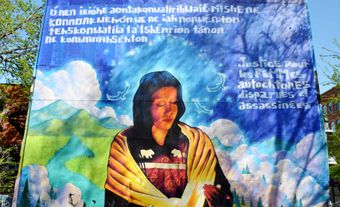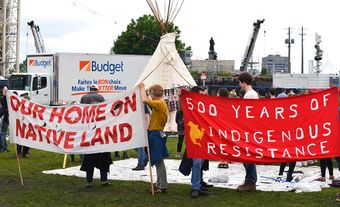Red Dress Day, also known as the National Day of Awareness for Missing and Murdered Indigenous Women and Girls and Two-Spirit People, is observed on May 5th. The day honours and brings awareness to the thousands of Indigenous women, girls and two-spirit people who have been subject to disproportionate violence in Canada. Red Dress Day was inspired by Métis artist Jaime Black’s REDress Project installation, in which she hung empty, red dresses to represent the missing and murdered women. Red dresses have become symbolic of the crisis as a result of her installation.

Missing and Murdered Indigenous Women and Girls and Two-Spirit People
Missing and Murdered Indigenous Women and Girls and Two-Spirit People (MMIWG2S) is a human rights crisis of gender-based and racialized violence in Canada. The number of victims of the ongoing tragedy is contested. A 2014 Royal Canadian Mounted Police report identified 1,181 Indigenous women and girls who went missing or were murdered in Canada between 1980 and 2012. (See also Highway of Tears.) However, Indigenous groups place this number at more than 4,000, citing underreporting and ineffective data keeping as reasons for the discrepancy. (See also Indigenous Women’s Issues in Canada.)
In Canada, Indigenous women, girls and members of the 2SLGBTQQIA (two-spirit, lesbian, gay, bisexual, trans, queer, questioning, intersex and asexual) community in Canada face disproportionate amounts of violence. While Indigenous women account for less than 5 per cent of the Canadian population, they make up 24 per cent of female homicide victims.
National Inquiry
Indigenous communities, women’s associations and human rights groups had long called for an independent federal inquiry into the crisis. It first received significant international attention in 2004, when Amnesty International released a report detailing the violence against Indigenous women and calling for action on the issue. In 2012, Cree journalist and leader Sheila North Wilson coined the hashtag #MMIW (Missing and Murdered Indigenous Women) to bring attention to the issue. The term has since expanded to MMIWG2S to include Indigenous girls and two-spirit people, members of the Indigenous LGBTQ+ community. ( See also Indigenous Women Activists in Canada.)
The 2015 Truth and Reconciliation Commission of Canada’s Calls to Action report identified 94 steps to address the legacy of residential schools in Canada. Call to Action #41 addressed the issue of disproportionate violence towards Indigenous women and girls and called for the creation of a public inquiry into the crisis.
In December 2015, the federal government pledged over $53 million for the establishment of the National Inquiry into Missing and Murdered Indigenous Women and Girls. The Inquiry’s mandate was to examine and report on the crisis and its causes. Over the course of two years, 24 hearings were held and 2,386 people participated in the process. The Inquiry’s final report was published in June 2019 and proclaimed that MMIWG2S is “a national tragedy of epic proportion.” The report outlined 231 Calls for Justice — legal imperatives to address, end and redress the crisis.
National Inquiry Facts
- Total number of participants in the Truth Gathering Process: 2,386
- Family members and survivors who provided testimony: 1,484
- Individuals who shared through artistic expressions: 819
- Experts, Knowledge Keepers and officials who provided testimony: 83
- Community hearings held across Canada: 15
- Knowledge Keeper, expert and institutional hearings held across Canada: 9
The REDress Project
Métis artist Jaime Black began the REDress Project, an art installation, in 2010. Black gathered and hung hundreds of empty, red dresses to represent the missing and murdered Indigenous women and girls in Canada. She described her artwork: “Through the REDress Project, the spirits of the missing or murdered women and girls stand with us here today, giving us courage, strength and clarity — leading us forward on the path to REclaim our sovereignty as indigenous women.” The first installation was at the University of Winnipeg in March 2011. The project gained attention, and Black soon received hundreds of donated red dresses from across the country. The REDress Project is now a permanent exhibit at the Canadian Museum for Human Rights and has been exhibited in Canadian universities, legislatures, hospitals and the Smithsonian’s National Museum of the American Indian. Red dresses are also frequently hung outside, from trees, houses or statues, to bring awareness to the crisis.
Black was inspired to create the installation after hearing Métis writer and educator Jo-Ann Episkenew speak about the missing and murdered women and witnessing a group of women in Bogotá, Colombia wearing red dresses and raising awareness for missing family members. Black also worked near the community of Indigenous murder victim Helen Betty Osborne. The idea of empty red dresses was inspired by the cover of The Book of Jessica: A Theatrical Transformation, co-authored by Linda Griffiths and Métis author Maria Campbell. Red was chosen for the dresses because it is powerful and eye-catching, and represents both vitality and violence. It was also chosen after Black learned from an Indigenous friend that red is the only colour that spirits can see, and which can be used to call the spirits of the lost back to reconnect with their loved ones. The project contributed to the popularity of red as a symbol of the MMIWG2S movement.
Red Dress Day
Inspired by Jaime Black’s REDress Project, Red Dress Day was first commemorated in 2010. The day is used to pay respect to the victims, raise awareness of the crisis and call on governments to take action to address the racialized and gendered violence inflicted on Indigenous peoples in Canada. Commemorations vary from community to community, but generally observers wear red and hang red dresses from trees, statues and doors. In some communities, marches, processions and vigils are held. While Red Dress Day is not a statutory holiday, it has gained increasing recognition across the country.
In some provinces, October 4th is also recognized as a day to honour Missing and Murdered Indigenous Women and Girls. Other commemorations include the February 14th Annual Women’s Memorial March, organized by women in the Downtown East Side neighbourhood in Vancouver. The first march was organized in 1992 in response to the murder of an Indigenous woman in the city and has been held annually to honour the missing and murdered. It has expanded to cities across Canada and the United States.

 Share on Facebook
Share on Facebook Share on X
Share on X Share by Email
Share by Email Share on Google Classroom
Share on Google Classroom






